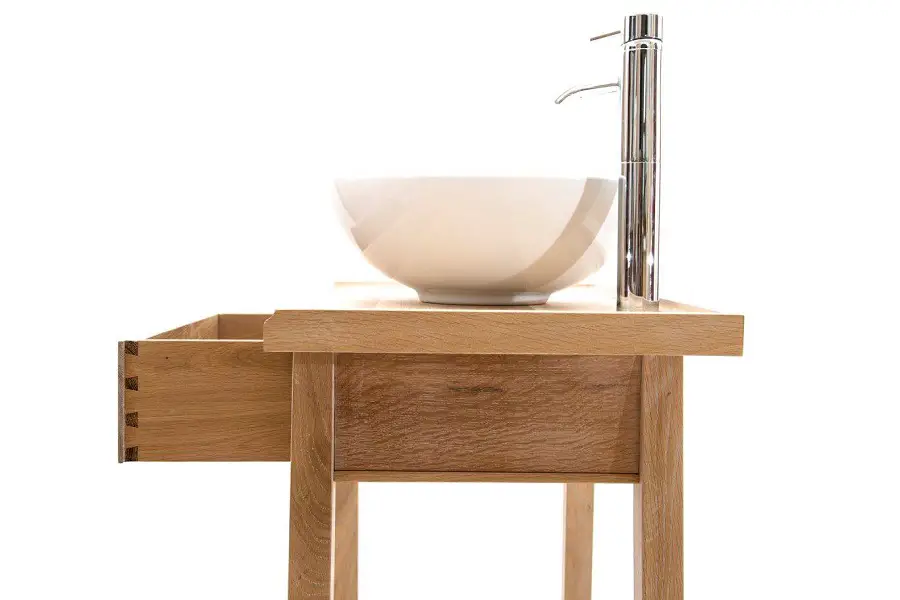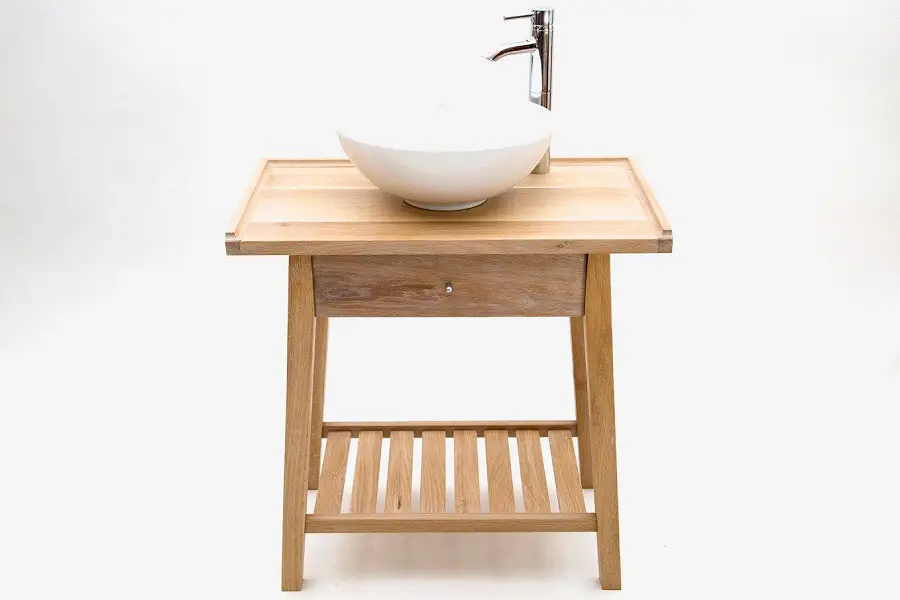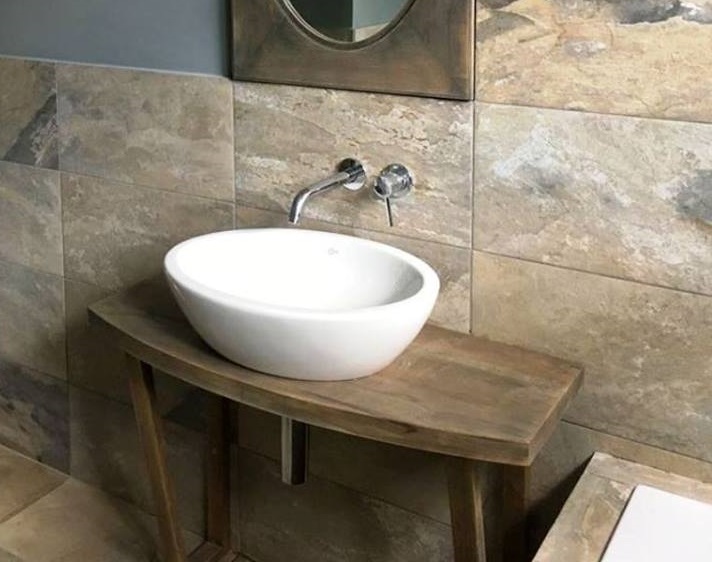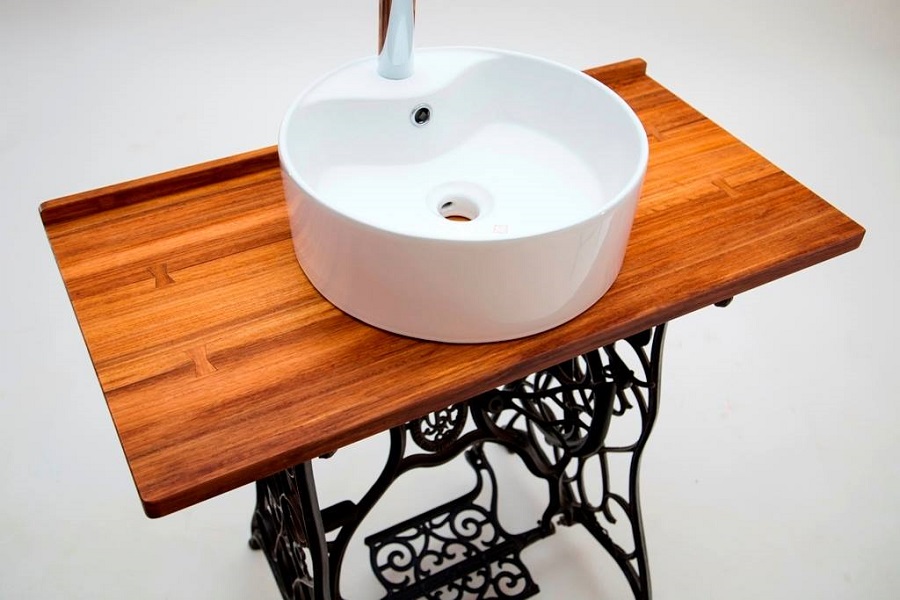The idea of using wood for bathroom furniture almost always comes up against the fear that it will not withstand the wet environment. This fear is unwarranted when you think of the wooden barrels used for bathing in the past, the Finnish saunas or the wooden barbecues you used to find in most bathrooms. Wood does well in these environments, and if protected, mould growth will be avoided. An oil-treated bathroom countertop holds up very well, provided that finish is refreshed when the oil wears off. Much more sensitive to water are glues that must be made with resistant adhesives and the materials or construction solutions used to make bathroom furniture. Let's see how we can finish a wooden countertop or furniture on which the bathroom sink rests to make them as moisture resistant as possible.

Protection with oils
Oil is the one that best highlights the wood and preserves its natural appearance. Those who appreciate it want to see and feel it even in more difficult conditions, such as in the bathroom. A bathroom worktop can be made from any wood, but the harder species (oak, ulm, acacia) or with resin content (spruce, pine, larch). It is best to use solid wood panel. If solid wood is used, it must be jointed in such a way as to avoid water stagnation. Always use moisture-resistant glue made of Classes D3 or D4. If wooden furniture is used instead of countertops, the design should be chosen so that there are no hard-to-reach areas. Water can easily get in there, but will be difficult to wipe off. The area will remain permanently damp and develop mould. Joints with glue or metal elements must also be moisture resistant.
If you choose oil to protect bathroom countertops or furniture, look for wood oil. There are several kinds of oil. You can use tung oil, linseed oil or blends of these oils - Danish oil or teak oil (it's not teak, it just looks like teak). There are also blends of different companies, more or less natural. I say less natural because there are also synthetic oils. In general, it is the price that shows how natural a product is. The higher the price, the cleaner and more natural it is. Natural oils can be used without any problems to protect the things we come into contact with. For objects that come into contact with food, use mineral oil.
In order to be as moisture resistant as possible, the wood needs to absorb oil deeply. It is therefore a good idea to apply excess oil, allow it to soak in for 30-45 minutes, then wipe the wood with a soft cloth that absorbs well and leaves no lint. Wiping is mandatory because otherwise the wood becomes sticky. Apply the oil with a soft cloth or brush, on both sides, on the edges, including the cut-outs. After 24 hours, the time needed for drying, the operation is repeated. This allows 2-4 coats to be applied. The wood must be properly dried (8-12% moisture content), sanded and stripped.

Protecting with moisture-resistant varnishes or paints
Those who do not trust oil or want a more durable finish that also ensures the mechanical resistance of protected surfaces can use varnishes or paints. They need to be moisture resistant because otherwise they bleach and flake. This is the case with nitrocellulose varnish, which is widely known and used. It is a nice-looking varnish, but very poorly resistant to moisture. It is not recommended for table tops either, let alone bathroom counter tops.
The most resistant varnishes in such cases are two-component varnishes, i.e. varnishes with chemical curing. This is the case polyurethane varnishes, acrylic, polyester. The chemical reaction between the two components of the varnish will result in a film with very good mechanical and physical-chemical resistance. The finished countertop or furniture will be much more resistant to moisture, scratches, abrasions and knocks. In this case too, the application must be made on both sides, on edges and in cut-outs. Apply 2-3 coats of varnish (or 1-2 primer + 1 varnish), with sanding between coats to obtain a surface as pleasant to the touch as possible.
If you are planning to protect the wood in your bathroom yourself, I recommend using water-based varnishes to avoid inconvenience caused by solvent evaporation. Even if they are not hardened they are strong enough to protect the wood from moisture. There is a possibility that the varnished surface may take on an opalescent appearance if it comes into contact with water immediately after drying. Don't panic! Water-based varnish has a longer deep drying period (up to 2-3 weeks), during which time it can absorb more of the existing moisture. The opalescence will disappear if you remove the source of moisture. Recovery will be faster if there is a heat source. It is a good idea to leave the worktop on for at least 48 hours after finishing before water reaches the surface.

Rules to follow for a durable finish
To make the finish last as long as possible, thus protecting your bathroom countertop or furniture, I recommend the following:
- Coat all parts of the worktop or furniture thoroughly with oil or varnish. Don't assume that if you have fixed the sink in the cut-out area very well, there is no need to finish that area. Water easily gets into the most hidden places. And if you don't notice this it is even worse. At some point you'll smell mold and you won't know where from;
- Refinish with oil when the surface of the wood begins to change its original appearance (sometimes it takes on a slightly dry appearance). Over time, the oil is removed by wiping or during cleaning. Don't let it disappear completely, it will be more difficult to repair. If you react as soon as the appearance changes, repair will be much easier. Simply wipe the surface with a cloth soaked in oil;
- Don't leave excess oil undried because it won't dry out. It will become sticky, unpleasant to the touch and very difficult to remove;
- After using the sink, do not allow water to puddle on the oiled surface. You will shorten the time until the finish is restored.
- Sand the surface of the wood before applying the protection. Raised fibre, in addition to its unpleasant appearance, can also be the way water gets into wood;
- Use very sharp objects carefully as they can damage the varnish film. The varnishes are resistant but not impossible to penetrate. The appearance of a deep scratch compromises protection. Water can get under the film and the finish fails.

The furniture presented in the article is made by iPlan Furniture - Dragos Costache and Constantin Iosif
Photos are property of iPlan Furniture
I hope you find the information useful. If you think it would be useful to others, you can share it. And if you have any questions, queries or want to make additions, leave them below in the space provided.






























Hello, I'm asking you what I have to give to a shower of ext. after giving it transformer oil!
Hello!
Only varnishes or paints based on white spirit (petrosin) or turpentine can be applied over the oil. However, these are low resistance varnishes and are not recommended for floors. Oil protection for outdoors is very good against moisture. The problem is that, over time, the oil is washed away by rain and the finish has to be re-done. It is recommended that at least once a year another coat of oil is applied so that the protection is maintained.
In terms of hardness, you have to rely on the hardness of the wood.
All the best!
Hello!
I would like to install a former chest of drawers in my bathroom in the living room, solid wood but I don't know exactly which one, it looks like oak.
Let me understand that the steps would be: degreasing with dishwashing detergent, sanding, one coat of primer, another sanding between the two coats, another coat of primer, then water-based varnish. Please fill in or correct if I have done something wrong. The sanding will be done with what grit?
Thank you!
Good evening!
The sequence of operations is very smooth.
Sanding off the old varnish or primer is done with 280 or 320 grit sandpaper or fine abrasive sponge.
Since you will be using the dresser in the bathroom, I recommend applying a thin coat of wood/wood wax over the last coat of varnish. The application is done after the varnish is completely dry (min.24 hours), with a soft cotton cloth, leave for 2-3 hours and then polish with a clean cotton cloth. The wax will protect better against water. It will block the pores of the oak, preventing water from entering. In addition, during the first month, until the reaction is complete deep in the coating, the water-repellent varnish absorbs moisture from the environment in which it is applied and can easily soften (becomes slightly milky). It recovers if the humidity drops and it is warm. After a month to a month and a half, the phenomenon disappears by itself. Wax will protect the lake and decrease the chances of this happening.
Good luck!
Good evening,
I have an old wooden tree that I want to use as a bathroom sink. What treatment can I use to make it waterproof? I haven't decided whether to leave it natural or paint it white.
If I leave it plain, is just oil enough? Flax, tung, mineral?
If I paint it, do I oil it first or apply paint directly? In how many coats? Can you give me a paint recommendation ( a brand)?
Good evening!
The most commonly used finish for sinks is epoxy resin and polyurethane varnish.
If you opt for oil, mineral oil is recommended for kitchen sinks and mineral or tung oil for bathroom sinks. The oil is applied in several successive coats, with wiping and a 24-hour drying time in between. The wood must be saturated with oil for the sink to be resistant. Paint, varnish or other material cannot be applied over the oil because it has no adhesion.
There is no need to stain the wood. You can first apply a water-based or solvent-based white varnish, let it dry, then apply the epoxy resin or oil treatment. This will make the wood grain more visible.
If you still want to paint it you should use white resin or white coloured oil and apply them like the transparent ones.
As a material recommendation - ICA from Lomilux.
In the link below you have a detailed description of how to finish wooden sinks.
Good luck!
https://revistadinlemn.ro/2019/08/02/chiuvete-din-lemn-tratamente-pentru-rezistenta-la-apa-intretinere/